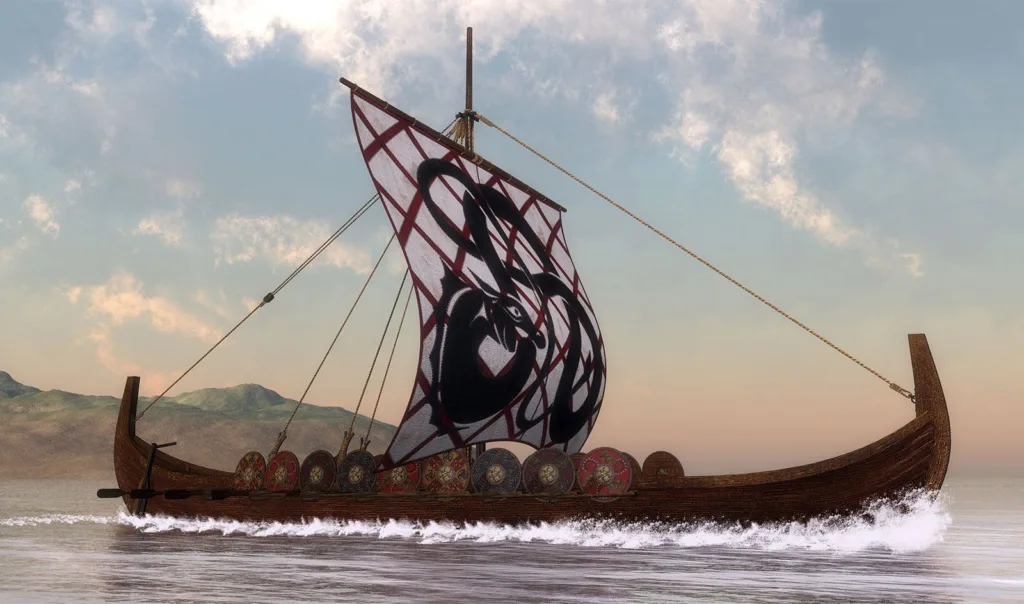Viking longships are one of the most iconic symbols of the Viking Age. These impressive vessels were designed to be fast, agile, and versatile, making them ideal for raiding, trading, and exploration.
One of the key features of the Viking longship was its ability to travel both on the open sea and on inland waterways. This was made possible by the ship’s shallow draft, which allowed it to navigate shallow rivers and estuaries with ease. The longship’s sleek, narrow design also made it incredibly fast, with some boats capable of reaching speeds of up to 30-35 kilometres per hour.
Another important feature of the Viking longship was its ability to carry a large crew. The boats were typically around 28-30 meters long and could hold more than 100 men. This was made possible by the ship’s oars, which were operated by a crew of up to 40 oarsmen, as well as a coxswain to steer the vessel. The longship’s large size and crew capacity made it ideal for raiding, as it allowed Viking warriors to quickly and efficiently raid coastal settlements and towns.
One of the most impressive things about the Viking longship was its seaworthiness. These boats were designed to withstand fierce ocean storms, with their sturdy construction and flexible design allowing them to navigate even the roughest waters. This made the longship an ideal vessel for exploration, as it allowed Viking sailors to travel far from home in search of new lands and opportunities.
Viking longships were an impressive feat of engineering and design. Their combination of speed, maneuverability, and seaworthiness made them ideal for a wide range of activities, from raiding and trading to exploration and colonization. Today, these impressive vessels remain an enduring symbol of the Viking Age, and a testament to the ingenuity and skill of the Viking people.
What Was Special About The Viking Longships?
Viking longships, also known as dragonships, were remarkable vessels that were specifically designed for Viking exploration, trade, and warfare. These ships were characterized by their sleek and narrow shape, which allowed them to glide through the water with remarkable speed and agility. The addition of oars and sails made them highly maneuverable, and they could navigate both shallow and deep waters with ease.
One of the most significant advantages of Viking longships was their ability to withstand harsh weather conditions. These ships were built to withstand fierce ocean storms, and their sturdy construction and flexible design allowed them to ride out even the most turbulent waters. Moreover, Viking longships had a shallow draft, which meant they could sail close to the coast and navigate rivers and estuaries where other ships could not.
Another aspect that made Viking longships unique was their carrying capacity. These ships could carry a large number of people, goods, and livestock over long distances, making them ideal for trade and exploration. Additionally, Viking longships were designed to be dragged across long portages, allowing Vikings to travel overland between rivers and seas.
Viking longships were a marvel of maritime engineering. Their speed, maneuverability, seaworthiness, carrying capacity, and ability to navigate shallow waters and withstand harsh weather conditions made them the most advanced and versatile vessels of their time.

How Many Vikings Were On A Longship?
Longships, also known as drakkar or dragonships, were the most iconic vessels used by Vikings. These ships were designed to be long, narrow, and flexible, allowing them to navigate through shallow waters, withstand harsh weather conditions, and move quickly. The number of Vikings on a longship varied according to the size and purpose of the vessel. However, on average, a longship could carry between 20 and 60 warriors, depending on its length and width. In some cases, larger longships could carry up to 120 men. These warriors were not only skilled navigators and sailors but also fierce fighters who used their ships as a means of transportation and as a weapon for surprise attacks. longships were essential to Viking culture and played a significant role in their explorations, raids, and conquests.
How Fast Did Viking Longships Go?
Viking longships were known for their speed and agility, which made them a formidable force on the water. These ships were designed to be around 28 – 30 meters long and had the capacity to hold more than 100 men. In terms of speed, Viking longships were able to reach up to 30 – 35 kilometers per hour, which is quite impressive considering they relied on both oars and sails. This combination of propulsion methods allowed the Vikings to travel great distances, even in adverse weather conditions. The use of oars allowed the longships to navigate rivers and narrow waterways, while the sails were used to catch the wind and propel the ship forward. the speed and versatility of Viking longships played a significant role in their success as explorers and warriors.
Could Viking Longships Be Carried?
Viking longships were light enough to be carried over land. Despite their size and durability, longships were designed to be easily maneuverable on both water and land. This was an important feature as Vikings often needed to transport their ships across narrow strips of land between rivers or bodies of water. In fact, this feature of the longship allowed the Vikings to launch surprise attacks from unexpected locations, catching their enemies off guard. So, to summarize, Viking longships were indeed light enough to be carried, making them versatile and effective vessels for both water and land travel.
Conclusion
Viking longships were truly remarkable vessels that played a crucial role in the expansion and success of Viking culture. They were designed to be both fast and durable, capable of navigating through rough seas and shallow rivers. With their unique combination of oars and sails, the longships were able to travel at speeds of up to 35 kilometers per hour, making them a formidable force on the water. The ability to carry a large crew of up to 100 men, as well as being light enough to be carried over land, made them a versatile and highly effective mode of transportation. Their impact on Viking culture cannot be overstated, as they served as powerful symbols of the Viking spirit of exploration, adventure, and conquest. the Viking longship remains one of the most iconic and enduring symbols of maritime history, and its legacy continues to inspire awe and admiration to this day.












